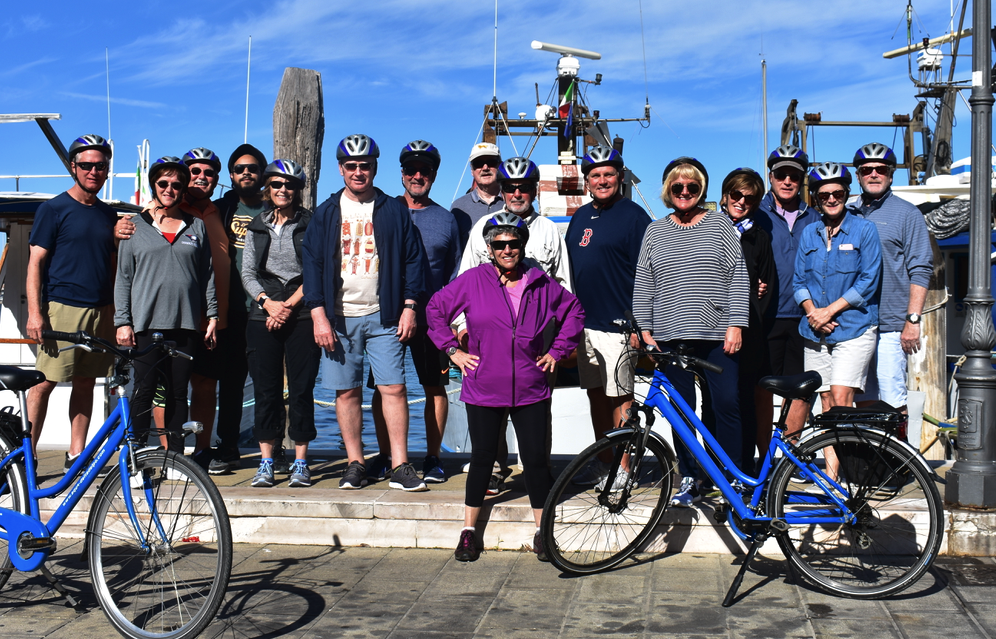Where the food comes from — on a Uniworld River Cruise

By Eileen Ogintz
CHIOGGIA, ITALY (DAY 5) — Got the Amaretto?
It’s very important, Uniworld River’s CountessPastry Chef Domnica Alexandru says at she demonstrates how to make the popular Italian desert Tiramisu—a delectable confection made with egg yolk, sugar, Mascarpone (cream cheese) and Amaretto, with ladyfingers.
We are cruising the Venice Lagoons after a morning spent in the fishing area of Chioggia, which has a larger wholesale fish market than Venice. While some of us biked to Sottomarina beach, past the busy weekly Thursday market, all of the fishing boats. By 10:30 a.m., “they are all back from work,” explains our guide Sara Milani.

We bike through tiny alleys where laundry is hanging out in the sunshine and old men are chatting over espresso; At the beach young people are windsurfing while others walk on the pathway that divides the Adriatic Sea from the Venice Lagoons.
Chioggia is known as “Little Venice,” because in the 14thCentury, Venice fought a war here with Genoa over the valuable salt—destroying the city in the process; When the Venetians won, they rebuilt the city thus the “Little Venice” moniker.

When we get back, we stroll through the market that seems to sell everything—one stand nothing but bike parts (everyone rides bikes here) to different colored espresso pots, chirping birds in cages, coats, shoes, suitcases, sheets, kitchen utensils, underwear… the best part is the local fish market where we see sardines, eel, branzino, anchovies, shrimp.
We get back to the River Countess in time for lunch—A Seafood feast! Giant shrimp, anchovies and sardines, clams and mussels – known here as “back gold”, a pasta in a shrimp and lemon sauce along with salads, a whole salmon (flown in Fresh) veal and more—There is a huge Tiramisu cake – as later the pastry chef is demonstrating how to make Tiramisu –not that difficult, it turns out.

“In the last five years, we are working more and more with local providers, “ said Chef Bogdan Antonescu.
“We try to match the area with the food and get everything as fresh as possible.”
That means fresh pasta, vegetables from the Venetian Island of San Erasmo, Salami and prosciutto from local butchers, local wines. “This helps the local people too,” said Mladenovic.
In Vienna there would be sacher torte for desert and schnitzel ; sausage and sauerkraut in Germany; Goulash in Budapest, with regional cooking demonstrations and visits to the market with the chef.
After Chef Bogdan takes guests to Venice’s famous Rialto market Saturday morning, lunch will include some of what we see—octopus, for example and calamari.

Not only can the Kitchen—where the staff comes from six different countries—accommodate most every dietary issue—but they are sensitive to the fact that passengers want healthier, fresh food, smaller portions. “They just want a bite of five different deserts, not one big piece of cake,” says Hotel Manager Carmen Mladenovic, gesturing to the bite-sized treats–scones, cookies, sandwiches—set out for the daily afternoon tea.
Every morning there are smoothies in the “healthy corner,” that don’t have any added sugar—spinch, avocado, beetroot, celery and apple; carrot ginger banana.
Several nights a week, they can “build their own pizza, some topped with French fries and sausage” as the chef offers tips on pizza-making in a sunroom on the top level of the ship.
Guests also are very interested in knowing where their food comes from these . “They want to experience the tomato that is grown in Venice,” said Mladenovic.
They also want to be more active–there are at least one “Let’s Go,” excursion weekly that we did, typically drawing 20 or so passengers, though the average age on board is 60-something.
Our ride this morning was a mellow eight miles around the Lagoon—but enough that we didn’t feel guilty eating that big, delicious lunch.
Is it time for dinner already?
